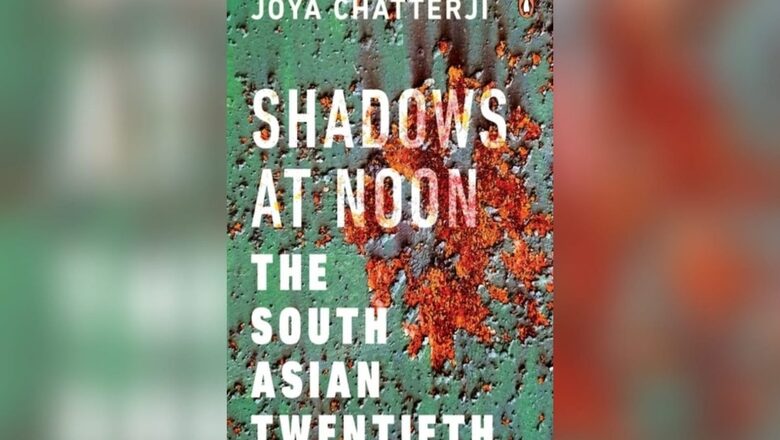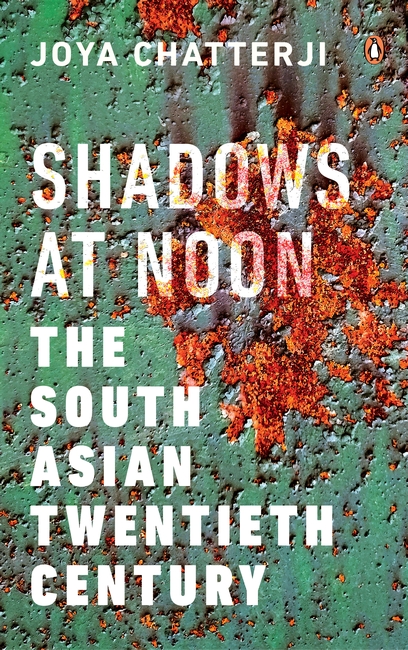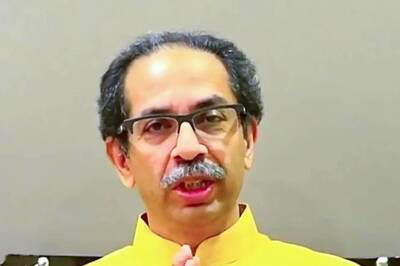
views
Joya Chatterji’s (JC) oversized tome, Shadows at Noon: The South Asian Twentieth Century (Penguin-Random House, 2023), is a weighty contribution to the intensifying battle to reaffirm control over India’s national narrative. JC’s book portends to become the standard reference work on India, included in its university history and humanities curricula and recommended as essential reading to IAS and IFS trainees. It ranges somewhat awesomely over a huge expanse of issues, from colonial history, politics and eating habits to religion, films, leisure and a great deal more. One cannot but admire the author’s daunting stamina and some of her book can be read profitably.
However, assessing JC’s book conscientiously, one cannot but feel troubled by its orientation and perspectives on India, its people and civilisation. Joya Chatterji offers a fundamentally biased and distorted view of the history of the Indian subcontinent. Although my review essay scrutinizes her arguments in some detail, its focus is on contentions that especially dismay rather than being a survey of the narrative of the book in the sequence in which she marshals her material.
With its studied propaganda about essential questions ‘Shadows at Noon’ has the imprimatur of Cambridge and Penguin to sway the ill-informed and inevitably mislead the naïve reader. It is quite ideologically sophisticated and almost as nuanced as the assiduously marketed book on India’s Islamic conquests by Richard M. Eaton’s ‘India in the Persianate Age 1000-1765’. Both books only need to be supplemented by Tirthankar Roy’s apologetics about the intervening historical period of colonial British servitude, from 1765 to 1900, in order to fully usurp India’s agonised thousand-year history by a self-congratulatory colonial narrative.
The 780 pages of ‘Shadows at Noon’s’ rambling actual text are organised into seven chapters and an epilogue, which discusses overlapping issues and its historical chronology is not sequential. It quickly struck me how JC’s work vividly demonstrates, once again, how India remains, in many important respects, an occupied country, with much of its intellectual life and consciousness of its very selfhood still under foreign hegemony. JC’s book, aimed at an uninitiated popular audience is a reconfirmation of Indian intellectual vassalage. This predicament reminds me that India merely acquired Dominion status in 1947, its armed forces were commanded by Englishmen until the mid-1950s and its prime minister was the product of a British public school and Cambridge.
It may be expedient to begin the review with Joya Chatterji’s concluding parts dealing with the most recent period, which will especially interest readers. Her assiduous concern for Pakistan is immediately revealed with her abbreviated discussion of the critical issue of the Durand Line. In reality, Pakistan only actually means the Punjabi military caste that controls its economy, society, and bureaucracy and has ruled it with the support of the Anglo-American masters of the universe. She fails to mention that the Durand line is not merely disputed, as she puts it genially, but is now the occasion for military clashes between Pakistan and Afghanistan. Ironically, Pakistan earlier regarded Afghanistan merely as a space for its make-believe strategic depth in defence rather than a fully sovereign nation.
Joya Chatterji is apparently uneasy about the Indo-Bangladesh border being fenced, although an estimated thirty million Bangladeshis have already entered India illegally, along with terrorists and couriers of counterfeit currency. India is the only country in the world about which such mindless drivel is peddled on spurious humanitarian grounds. JC’s tortured unrealism about a shared subcontinental destiny unfolds unstoppably, heedless of the blind hatred even Pakistani schoolchildren express for India. In a forlorn effort to create national identity and unity, Pakistan cynically brainwashes its children with degraded religious instruction while Indian children animatedly talk science, but JC speaks of the fragile nationhood of both India and Pakistan. She rejects any presumption of distinctive Indian and Pakistani identities as ‘hyperbolic’ and the perception of a ‘glass half full’.
JC’s maudlin sentimentality about subcontinental cultural commonality persists throughout and she describes its severing by partition as an example of Deborah Levy’s pedestrian idea that ‘sorrow does not have a century’. Other examples of even greater tragedy have occurred around the world during the twentieth century, even in recent decades, not least in the Congo and Rwanda where the scale of fratricidal killings has been unprecedented. Pakistan, as a nation, has proven a demonstrably artificial geopolitical construct and is now on its knees while the people of the other country are rediscovering their ancient civilizational roots together to literally reach for the stars.
At some point, JC proceeds to make a remarkably inappropriate remark about ‘war talk’ in relation to Bangladesh being liberated by India from intensifying genocide. Joya Chatterji’s account of the J&K dispute could have been the handiwork of a disingenuous lawyer on behalf of Rawalpindi and inaccurate to a fault, which is discussed further below in the review. More to the point, the matter is now closed and there is no purpose in revisiting the erroneous historical facts she cites. Nor does JC want to believe that Pakistan attempted to occupy Indian territory in Kargil in 1999 or that its army was bloodily ejected by India, despite public acknowledgement by retired Pakistani army officers (p. 739). There is no discussion of Pakistan’s terror attacks on India, continuing unremittingly from 1947 to this day. JC virtually dismisses the unprecedented terror attack against Mumbai in 2008 merely ‘as young men engaged in suicide killings’ and ignores the attempt by Pakistani terrorists to decapitate India’s entire political leadership in 2001.
The Indus Water Treaty signed in 1960, JC mentions, between India and Pakistan was an act of generosity on India’s part. But the excess water flowing into Pakistan since, beyond levels agreed levels in the treaty, may now be in jeopardy because India is likely to reclaim it. However, India has a wider national interest in upholding the treaty faithfully and has signed another one with Bangladesh as well. The implementation of the important subsequent Teesta River Water Sharing agreement between them has been held up by the government of West Bengal. In this context, it needs to be recognised that a significant aspect of the J&K dispute involves access to water resources of great significance for Pakistan. This is why it will never agree to the creation of an independent state of J&K, so much for the mournful handwringing by motivated historians about the sanctity of sovereignty. Although India and Pakistan reached an agreement on many issues that arose out of partition through a Steering Committee they created, JC laments the absence of Indian eagerness to help Pakistan become stably established. This is hardly surprising after the cataclysmic partition and Mohammed Ali Jinnah’s nefarious role in it. The reasons for India’s hesitancy in handing over Pakistan’s share of undivided India’s foreign exchange reserves are elaborated below.
JC refers to the callous outcomes imposed by unforgiving circumstances owing to partition, mass migrations, the abduction of women, the fate of religious places and evacuee property. She seems to applaud the disturbing bonhomie between senior Pakistani and Indian bureaucrats involved in the Steering Committee discussing these issues. They were apparently not unduly distressed by the horrors of partition, socialised no doubt by their antecedent Raj training to remain indifferent towards the suffering of ordinary people. The violence in the North was mutual while its brunt was borne by Bengali Hindus in East Pakistan. They were slaughtered in large numbers and lost property and investments and professional livelihoods. Left-liberal historians might view such violence against these Hindus as motivated by class antagonism towards wealth and privilege, much as they do in their portrayal of the Moplah genocide and sexual violence as a revolt against oppressive landlords.
The artfully tendentious tone of JC’s book is unmistakable early, with a veiled reference to subcontinental minorities who could ‘never prove their allegiance to the nation, whatever they did’. This assertion has no basis in fact since Pakistan’s constitutional provisions specifically exclude Hindus from public life and they were also rapidly liquidated as a populace. By contrast, India’s Muslims only grew in number and Indians also reverentially embraced any Muslim showing the slightest signs of patriotism, whether the former Indian President A.P.J. Kalam, India’s missile man, or the courageous archaeologist, K. K. Mohammed. But historical writing about India is overwhelmingly dominated by a collaborationist Left-Liberal narrative of colonial inspiration. This kind of contrived historical depiction had deepened with malice and forethought by the third quarter of the nineteenth century to outwit a recalcitrant Hindu majority, especially in Bengal. This instrumental ideological intellectual tradition was espoused enthusiastically in 1941 by Indian communist pen pushers and writers and subsequently by India’s benighted Left-Liberal academic cohort everywhere, especially its historians.
The Left still espouses a belief in the now discredited idea of universal history that is supposedly destined to transcend all ancient heritages though they have been careful not to probe its potential in Islamic societies. More mundane has been their shamefully longing gaze towards Oxbridge and the American Ivy League, hankering for even a seminar invitation. These hallowed portals abroad have since been stormed by a breed of alarmingly ideological nominally Hindu academic appointees, staunchly loath to bite the hand it feeds off. Three among them are women Cambridge historians, suffused with loathing towards India and its Hindu aspirations. There are also others of Oxbridge and Ivy League pedigree, with no empathy for Hindu yearnings, which they abhor.
In the meantime, Joya Chatterji speaks breezily of the shared unity of languages of the peoples of South Asia without irony since the attempt to impose Urdu broke the camel’s back of supposed subcontinental Muslim unity. It precipitated the creation of Bangladesh in 1971 to the accompaniment of genocidal bloodletting and mass rape by the Punjabi Muslim army of Hindu girls and women and their Bangladeshi co-religionists as well. The Pakistani soldiery sought to impregnate the wombs of fellow Muslims with proper future adherents of the faith. Joya Chatterji who demonizes defenders of Hindu interests astounds by cavalierly sidestepping such major human rights violations against them. But she worries about the nationalist fervour in India during the war that led to the creation of Bangladesh in 1971, but does not dwell on the killing of millions of Bengali civilians. JC only mentions the 350,000 or more women held in terrifying rape camps in passing, with some odious non sequitur artifice about ‘gendered representation’ of violence. Women’s clothing was also discovered inside roadside bunkers where Pakistani soldiers apparently pleasured themselves at leisure while awaiting the advancing Indian army. As a friend of the late Lt. General JFR Jacob, I had firsthand accounts of quite ghastly discoveries of the Indian army and this is the Pakistan depicted with empathy in Joya Chatterjee’s repugnant retelling of the creation of Bangladesh.

These are apparently issues that do not unduly trouble Left-liberal humanitarian souls and have, on the contrary, been denied altogether by one Indian woman writer, a Subhas Bose family scion. She quickly found a desirable berth at Oxford University on penning her shocking apologia for Pakistan’s soldiery. This is what passes for path-breaking scholarship according to the likes of Harvard’s Rana Mitter, Robert Frykenberg of Wisconsin-Madison and of course the irrepressible advocate of Pakistan, William Dalrymple. The internal politics and loyalties of the global academic ecosystem of India-baiters endure heedless of the dignity of intellectual integrity. Yet, it is noteworthy that all Indian governments have deferred to this pernicious ecosystem, overawed by its international credentials and ostentatiously grand European ethnicity since their own knowledge of the grim history of these institutions and their cynical personnel is lacking.
Joya Chatterji absurdly judges her experiences at Cambridge, supping with Pakistani counterparts who shared the same cuisine, and eating habits, using the same paring knives to cut onions and watching cricket together. She preposterously mentions their apparent shared admiration for the ‘doosra’ cricketing bowling technique. Yet, Joya Chatterji later dwells at great length on the defining role of highly complex dietary rules and eating habits creating profoundly differentiated Hindu-Muslim cultural identities and the Muslim resolve in resisting the Hindu Brahmin vegetarian diet. In JC’s account, Muslims apparently also always satisfied a craving for meat, however poor and disregard other Hindu injunctions related to satvik, rajsik and tamsik qualities of food. In addition, Muslims choose to adorn the distinguishing attire of the lungi to assert their distinctive identity (p.563–65). They also ignore the mandatory Hindu disavowal of any food polluted by another’s saliva, which therefore becomes ‘jhoota’ as a result. They partake from the same platter, forming a primordial sense of battleground communal bonding through the practice. JC deems such commensality as more democratic than alleged Brahmin modes of serving food sequentially, in accordance with alleged status hierarchies.
Nevertheless, JC insinuates that despite such differences in food habits and social culture, inborn attachments and intimate interaction apparently once existed in the Indian subcontinent between Hindus and Muslims, the Moplah genocide, Noakhali massacres and Great Calcutta Killings notwithstanding. What is shocking is JC’s idea that the alleged phenomenon of such interactive neighbourliness suffices to create deep bonds of amity among people. Unfortunately for her puerile argument, it is the very Muslim neighbours that turned viciously against Hindus in Bengal and Punjab in 1947, Kashmir in 1991 and, more recently, the Yezidis of Iraq. This deeply unhistorical contention would also suggest that Jews had nothing in common with their fellow Germans and Eastern Europeans. Many of them were enthusiastic slaughterers of their Jewish neighbours in Poland, the Ukraine and Lithuania. Nor did the Croatian Ustasa, speaking the same language and eating the same food, have any compunction killing Serbs and Jews en masse during WWII, with a brutality that even shocked German Nazis.
This is the parlous state of historical writing on the Indian subcontinent with the usual suspects praising JC’s recurrent juvenile contentions in breathless reviews. Other non-sequiturs of JC leave one gasping for breath: “An Englishwoman’s romantic liaison with an ‘untouchable’ sweeper questions the much-vaunted ‘super-racism’ of white women in India, while also shedding light on the lives and experiences of Dalits.” Is this being insinuated as the norm by which to judge the widely acknowledged racism of white English women of empire that thoroughly poisoned social relations in the Raj between Indians and their alien rulers? Notices used to be hung in a Bengaluru club entreating white British members not to beat native Indians, suggesting such appalling behaviour was not uncommon.
JC persists with the totally fabricated idea that after 1947 India, Pakistan, and Bangladesh experienced similar sociopolitical trajectories of creating enforced identities when this is patently false. India’s Nehruvian elites bent over backwards, with a portfolio of legislation to appease and reassure India’s Muslims. Their population size has since grown inexorably, poised to become a majority in West Bengal and Assam through illegal migration. By contrast, Hindus and other minorities in India’s two theocratic neighbours were mostly extinguished and destined to be wiped out completely. Quite hilariously, one of her Oxford academic colleagues once demanded, in a BBC debate with me, that India should open its doors wide to ‘persecuted Muslims’ from Pakistan. This evidently unbalanced interlocutor also supported, in the bargain, the Shaheen Bagh protesters who thwarted the accord of citizenship to persecuted Sikhs and Hindus who had fled to India. Instead of imposing any sort of uniform citizenship India’s federal structure has sought, instead, to institutionalize parochial regional identities, with critical aspects of policy decisions, on subjects like education, devolved to individual state governments. India’s constitution also grants extensive privileges to Muslims and Christians to manage their own religious and pedagogic institutions, allowing discrimination against Hindus while enjoying generous state funding.
Worse, JC’s self-willed ignorance or deliberate obscuring of reality fails to refer to the ample documentary evidence of Pakistan’s creation as a British geopolitical goal and its rule ever since by foreign-sponsored military dictators. Quite unbelievably, she describes Pakistan’s foreign policy as nonaligned and anti-imperialist, which is completely contrary to the facts. Pakistan was to become an Anglo-American vassal officially from the outset, with its membership of Seato and Cento in the 1950s. Pakistan has now effectively surrendered its sovereignty to China although their dalliance also dates back to the 1950s when China told Pakistan that its membership of the two US-sponsored alliances would not affect their relationship (p.741). Besides, its prime ministers, according to Pakistan scholar, Christine Fair, have been the equivalent of city mayors, irrelevant to the imperial powers which direct its fate.
Joya Chatterji does reiterate the view of Indian nationalists about the hugely detrimental effect of colonial rule, from de-industrialization to famines. However, in the context of India’s independence struggle, she persists with the standard refrain about divisions between moderates and extremists within the Congress. This distinction is no longer credible and collaborators is a more accurate depiction of the so-called moderates. Such moderates, sensitive to the interests of the departing colonial power, have always enjoyed favourable portrayals by colonial historians. The conflation of Hinduism with upper caste that JC also insinuates has always been a colonial and evangelist slander to discredit the entire nationalist movement although she does acknowledge the racist vitriol of the white community fueling the revolutionary movement of Bengal. There was massive surveillance on virtually the entire Bengali middle class as well, impacting even the likes of Swami Vivekananda and Rabindranath Tagore, which only spread deepening alienation further. Surprisingly, there is barely any analysis by Joya Chatterji of the revolutionary upsurge in Bengal after the early twentieth century that lasted into the late 1930s, with only a glancing reference to ‘revolutionary terrorist societies’ (p.54). According to the British authorities, it had spawned the ‘terrorist’ Subhas Bose, who was to become the principal raison d’etre of British withdrawal from India.
JC’s distortions parallel the Cambridge School libel of her husband Anil Seal, et. al. He alleged the real motivation of the Congress Party was to gain privileges for India’s elites and amounted to little else besides. Both husband and wife subliminally articulate an Islamist view of the British colonial administration that had prompted it to calculatedly sponsor the creation of the Muslim League in 1906. This conspiracy was designed to counter an essentially Bengali Hindu revolutionary movement of the early twentieth century. According to JC, the Hindu cultural motifs of the independence struggle apparently account for Muslims mostly looking askance at Indian nationalism. Yet, she herself notes their deeply transnational Islamic political consciousness and loyalties, even as early as the nineteenth century. It was accompanied by dogged efforts to uphold obscurantist Islamic tradition and repudiation of English education. Even Sir Syed Ahmed Khan’s modest attempts to expose his community to Western science and ideas were rejected. Paradoxically, the consequential obliviousness of Muslims to Western education later became the justification for the liquidation, en masse, of Hindu professionals in East Pakistan. They were accused of dominating the professions by virtue of their proficiency in English and Westernized educational qualifications. At the bottom, the Indian Muslim perceptual political universe therefore diverged radically from a specifically Indian nationalism. Indian nationalists were not contemplating the restoration of their erstwhile political primacy over the Indian subcontinent that Muslims sought.
Joya Chatterji is loftily judgmental about the admittedly flawed subsequent Indian attempts at nation-building without some sympathy for the enormity of the task in a nation virtually destitute and reeling from the bloody chaos of partition. She is apprehensive about Indian nationalism as if it is a unique phenomenon in history rather than an unfortunate necessity in a world of predatory states, as Rabindranath Tagore had once astutely observed. Her jubilant denunciation of Indian nationalism as Hindu and upper caste begs the question on what other basis could Indians have challenged British rule if not by appeal to memories of their own historical and cultural roots and led by the educated?
Joya Chatterji’s imperious observation that the demolition of the derelict Babri structure was a watershed moment in India and worse than 9/11, in which thousands of innocents died, seems to dismayingly endorse the view of diehard Islamic extremists. They too condemned the demolition of the turret and roof of the Babri structure as an unforgivable outrage. In their punitive outlook, the act merited the copious shedding of Hindu blood although it was merely a monument to Hindu degradation. Her odious contention could be mistaken for the implicit rationalization of countless acts of Islamic terrorism that followed in the wake of the demolition. These included the burning alive of pilgrims and their families on the Godhra train and the killing of worshippers at the Akshardham temple. JC later whitewashes the Moplah genocide as a rebellion against Hindu landlords despite a mountain of evidence underlining it was no such thing, but a typical Islamist outrage against the hated Kafir.
In fact, her penchant for unashamed apologia for Islamism effectively constitutes a calculated obverse of the rejection of the entire legacy of Hindu civilisation and its modern protagonists, from Ram Mohan Roy and Bankim Chandra Chatterji to Rabindranath Tagore and Swami Vivekananda. It is worth recalling that it was the progenitor of the Bengali Hindu renaissance and India’s embarkation towards modernity, Raja Ram Mohan Roy, who had knelt in prayer to thank the Almighty for the ending of Muslim rule in Bengal by Robert Clive. Significantly, JC celebrates India’s Muslim cultural and political legacy with some breathless adoration though disparaging the promotion of Hindi in independent India as ‘stuffed’ with Sanskrit. She even finds a moment to grieve the destruction of Shahajanabad and the Great Daryaganj Mosques in the aftermath of 1857, faded symbols of the grandeur of Mughal invaders who laid waste an entire civilisation. As a corollary, the Babri structure evidently ought to have been preserved unspoiled and the Ram Mandir must consequently be seen as an abomination.
To be continued
The writer taught international political economy for more than two decades at the London School of Economics and Political Science. Views expressed in the above piece are personal and solely that of the author. They do not necessarily reflect News18’s views.




















Comments
0 comment